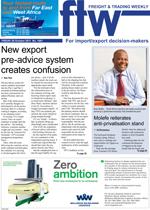A report that predicted that
container capacity would
exceed demand by as much
as 10% for the next three
years, and suggests that
the gap won’t substantially
improve for five years,
was described to FTW as
“sheer blooming scary” by a
Johannesburg-based shipping
line executive.
“The shipping future
looks bleak,” he added, “and
many casualties are likely to
happen. Five years of downturn
is a long time.”
And, to make matters
worse, the forecast estimates
also assumed no slump in
world economic output – a
bit of wishful thinking when
you look at the US and
European debt crises. You
can add Asia to this, as it
faces “severe macroeconomic
and financial spill-overs”
from deteriorating economic
outlooks in the other two
continents, the International
Monetary Fund (IMF) said
just two weeks ago.
The man who told the
bleak story was Neil Dekker,
head of container research
at shipping consultants,
Drewry. His quarterly
Container Forecaster data
showed that capacity in the
container market would
rise 29% in the three years
ending in 2013. Demand will
grow by only 19% in the
period.
Dekker also said there
would not be a “major”
improvement in the balance
between supply and demand
for five years. “Freight rates
are very low,” he added.
“It would be logical to lay up
vessels, but that’s not really
happening.”
Adding more grief to
the global overcapacity scene
is a continuing urge amongst
the major container lines to
build newer and bigger ships.
The latest edition of
Bloomberg Businessweek
has quoted an estimate from
the Paris-based industry
consultants, Alphaliner, as
saying that container lines
have booked orders for new
ships for a combined
US$57-billion.
Over the next four years,
the Alphaliner report added,
new ships will add capacity
equivalent to 4.5 million
standard 20-foot containers
to today’s 15.2m TEUs.
Meantime the Denmarkbased
shipping trade group,
Baltic and International
Maritime Council (Bimco)
said in a report that vessels
that can haul the equivalent
of about one million TEUs
will need to be idled or
laid up.
It also pointed to the
fact that ships were being
built larger, with the size of
container ships having more
than doubled over the
past decade.
Illustrating this, Alphaliner
said that new deliveries this
year on average carry 6 100
TEUs, compared with 2 900
TEUs in the year 2000.
Drewry issued similar
bigger ship data. It said that
the size of the world’s fleet
of ships with capacity larger
than 8 000 TEUs would
increase by more than 20%
annually over the next years,
outpacing overall supply
growth.
This overcapacity,
slimming demand, and rates
being cut to ribbons, would
inevitably lead to the lines
with less financial muscle in
reserve coming to grief.
“On its current course
the industry will struggle to
turn profitable,” Ross Porter,
Norway-based fund manager
at Skagen, told Bloomberg.
Overcapacity may thin out
the industry, with only the
biggest companies surviving
the pressure on freight rates,
he added.
And this oversupply
cascades down to the lesser
trades around the world.
It has already been evident
on the SA trade, with the
largest container ship to
call at Durban having
now reached a 9 600-TEU
capacity – almost double
the size of the 4 500 - to
5 000-TEU vessels that rated
headline news only a couple
of years ago.
And the result of this,
if these extra-biggies
continue to trade to SA, will
inevitably be even greater
oversupply than there is at
the present (particularly on
the Far East-SA trade) – and
a resultant cutting of freight
rates, and serious pressure on
lines which serve SA.
‘Expect casualties as shipping oversupply looms’
28 Oct 2011 - by Alan Peat
0 Comments
FTW - 28 Oct 11

28 Oct 2011
28 Oct 2011
28 Oct 2011
28 Oct 2011
28 Oct 2011
28 Oct 2011
28 Oct 2011
28 Oct 2011
28 Oct 2011
Border Beat
Featured Jobs
New
New
